Keeping shrimp in an aquarium can be a rewarding experience, but success hinges on proper stocking practices. Understanding how many shrimp to keep per gallon of water is crucial for maintaining a healthy, thriving ecosystem within your tank.
Importance of proper stocking in shrimp tanks
Proper stocking density is vital for several reasons:
- Water quality: Overstocking can lead to rapid deterioration of water quality, as more shrimp produce more waste.
- Stress reduction: Appropriate population levels help minimize stress on individual shrimp.
- Resource availability: Proper stocking ensures adequate food and hiding spaces for all inhabitants.
- Disease prevention: Overcrowding can increase the risk of disease outbreaks and spread.
Factors affecting shrimp density
Several factors influence the number of shrimp a tank can comfortably support:
- Tank size and water volume
- Filtration efficiency
- Shrimp species and their specific requirements
- Presence of other tank inhabitants (fish, snails, etc.)
- Aquascaping and available surface area
- Feeding practices and maintenance routines
This guide aims to provide a comprehensive overview of shrimp stocking practices, helping aquarists determine the ideal number of shrimp per gallon for their specific setup. By considering various factors and following expert recommendations, you can create a balanced and thriving shrimp ecosystem in your aquarium.
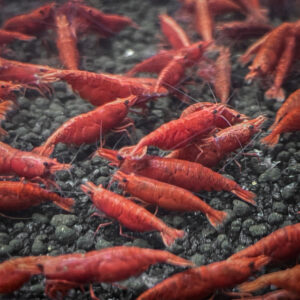
General Guidelines for Shrimp Stocking
While there’s no one-size-fits-all approach to stocking a shrimp tank, some general guidelines can help aquarists make informed decisions.
Basic rule of thumb for beginners
For novice shrimp keepers, a conservative starting point is:
- 2-5 shrimp per gallon for tanks under 20 gallons
- 5-10 shrimp per gallon for larger tanks (20+ gallons)
This conservative approach allows beginners to gain experience while minimizing risks associated with overstocking.
Differences between Neocaridina and Caridina stocking rates
Neocaridina species (e.g., Red Cherry Shrimp):
- Generally hardier and more adaptable
- Can be stocked at slightly higher densities, up to 10-15 per gallon in well-maintained tanks
Caridina species (e.g., Crystal Red Shrimp):
- More sensitive to water parameters and environmental changes
- Should be stocked at lower densities, typically 2-5 per gallon
- Require more stable conditions and often specialized care
Why “it depends” is often the correct answer
The ideal stocking density for shrimp tanks isn’t a fixed number, as it depends on various factors:
- Tank maturity: Newer tanks should be stocked more conservatively than established ones.
- Filtration capacity: Better filtration can support higher shrimp populations.
- Plant density: Heavily planted tanks can accommodate more shrimp due to increased surface area and natural filtration.
- Maintenance routine: More frequent water changes and tank cleaning can support higher densities.
- Breeding plans: If you intend to breed shrimp, start with lower numbers to allow for population growth.
- Individual shrimp size: Larger species require more space per individual.
- Presence of other tank inhabitants: Fish or snails will reduce the carrying capacity for shrimp.
Given these variables, the most accurate answer to “How many shrimp per gallon?” is often “it depends.” Successful shrimp keeping requires ongoing observation and adjustment based on your specific tank conditions and the well-being of your shrimp population.
Factors Influencing Shrimp Stocking Density
Several key factors play a crucial role in determining the appropriate number of shrimp for your tank. Understanding these elements will help you make informed decisions about stocking your shrimp aquarium.
Tank size and surface area
- Larger tanks generally allow for higher shrimp densities due to greater water volume stability.
- Surface area is often more important than volume for shrimp, as they spend much time grazing on surfaces.
- Increased surface area from decorations, plants, and hardscape allows for higher stocking densities.
Filtration efficiency
- More efficient filtration systems can support higher shrimp populations by maintaining water quality.
- Consider both mechanical and biological filtration capacity.
- Oversized filters or supplementary filtration (e.g., sponge filters) can allow for increased stocking.
Plant density and hiding spaces
- Heavily planted tanks can support more shrimp due to:
- Increased surface area for grazing
- Natural filtration provided by plants
- Additional hiding spaces reducing stress
- Moss, leaf litter, and dense plant growth are particularly beneficial for shrimp.
Shrimp species and size
- Smaller species (e.g., Cherry Shrimp) can be kept in higher numbers than larger species (e.g., Amano Shrimp).
- Some species are more active or territorial, requiring more space per individual.
- Species-specific needs (e.g., water parameters, diet) affect optimal stocking density.
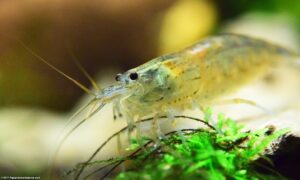
Breeding intentions
- If breeding is a goal, consider starting with lower numbers to allow for population growth.
- Breeding colonies may require more space and resources as the population expands.
- Some species breed more prolifically than others, affecting long-term stocking considerations.
- Plan for potential need to separate or cull offspring to maintain appropriate population levels.
Understanding these factors and how they interact in your specific setup is crucial for determining the ideal shrimp stocking density. Regular observation and willingness to adjust your approach based on the shrimp’s behavior and overall tank health are key to successful shrimp keeping.
Neocaridina Shrimp Stocking Rates
Neocaridina shrimp, including popular varieties like Red Cherry Shrimp, are hardy and adaptable, making them suitable for various stocking densities. However, optimal stocking rates can vary based on tank conditions and keeper goals.
Recommended densities for different tank sizes
- 5-gallon tank: 10-25 shrimp
- 10-gallon tank: 25-50 shrimp
- 20-gallon tank: 50-100 shrimp
- 30-gallon tank and larger: 5-10 shrimp per gallon
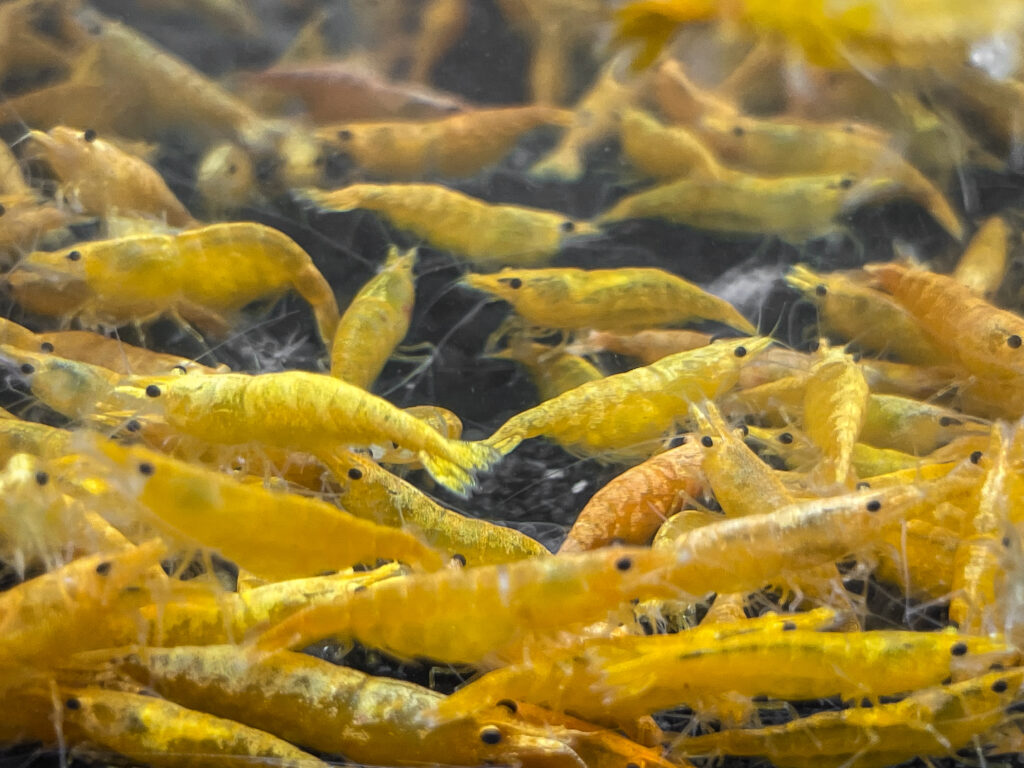
These numbers assume a well-maintained, established tank with adequate filtration. For newer setups or less experienced keepers, start with the lower end of these ranges.
Considerations for heavily planted tanks
Heavily planted tanks can support higher shrimp densities due to:
- Increased surface area for grazing
- Natural filtration provided by plants
- Additional hiding spaces reducing stress
In well-planted tanks, you may be able to increase the recommended densities by 20-30%. For example:
- 10-gallon planted tank: 30-65 shrimp
- 20-gallon planted tank: 60-130 shrimp
However, monitor water parameters closely when increasing density, and be prepared to adjust if needed.
Adjustments for breeding colonies
Neocaridina shrimp are prolific breeders, which requires special consideration for stocking:
- Initial stocking: Start with a smaller colony of 10-20 shrimp in a 10-gallon tank.
- Gender ratio: Aim for a 1:2 male to female ratio to start.
- Growth expectations: A healthy colony can double in size every 3-4 months.
- Space planning: Allow room for population growth or be prepared to remove excess shrimp.
- Carrying capacity: Even in ideal conditions, population growth will eventually stabilize based on available resources.
For breeding setups:
- 10-gallon tank: Start with 10-20 shrimp, expect up to 100-200 after several months
- 20-gallon tank: Start with 20-40 shrimp, expect up to 200-400 after several months
Remember, these are general guidelines. Regular observation of your shrimp’s behavior, growth rates, and overall tank health is crucial for determining the ideal population for your specific setup. Be prepared to adjust your stocking levels or increase maintenance as the colony grows.
Caridina Shrimp Stocking Rates
Caridina shrimp, which include popular species like Crystal Red Shrimp and Tiger Shrimp, generally require more precise care and lower stocking densities compared to their Neocaridina cousins.

Why Caridina often require lower densities
- Higher sensitivity to water parameters: Caridina shrimp are less tolerant of fluctuations in water quality.
- Slower reproduction rates: They typically breed less prolifically than Neocaridina.
- More specific dietary needs: Many Caridina species have stricter nutritional requirements.
- Lower stress tolerance: They can be more easily stressed by overcrowding.
- Specialized habitat requirements: Some species need specific water conditions that are harder to maintain in higher densities.
Recommended numbers for various tank sizes
As a conservative guideline, consider the following stocking rates for Caridina shrimp:
- 5-gallon tank: 5-10 shrimp
- 10-gallon tank: 15-25 shrimp
- 20-gallon tank: 30-50 shrimp
- 30-gallon tank and larger: 2-4 shrimp per gallon
These numbers assume a well-established, properly maintained tank with appropriate water parameters for the specific Caridina species.
Special considerations for sensitive species (e.g., Crystal Red Shrimp)
Some Caridina species, like Crystal Red Shrimp (CRS), require extra care and lower stocking densities:
- Water parameters: Maintain very stable, soft water with low pH (usually 6.0-6.5) and TDS below 150.
- Start small: Begin with a group of 5-10 CRS in a 10-gallon tank to ensure stability.
- Gradual increases: Only add more shrimp once the initial group is thriving and breeding.
- Maximum density: Even in ideal conditions, limit CRS to about 5 per gallon in larger tanks.
- Breeding considerations: Provide ample hiding spots and leaf litter for shrimplets.
- Specialized filtration: Consider using active substrates and remineralizers to maintain ideal water chemistry.
- Temperature control: Many sensitive Caridina species prefer cooler temperatures (68-74°F), which can limit bioload capacity.
For particularly sensitive or valuable Caridina species:
- Err on the side of lower stocking densities
- Increase water change frequency
- Monitor water parameters closely
- Consider using RO water remineralized to exact specifications
Remember, successful Caridina keeping often relies more on maintaining pristine water conditions than maximizing the number of shrimp per gallon. It’s better to have a smaller, thriving colony than a larger, stressed one.
Mixed Species Tanks
While single-species shrimp tanks are popular, many aquarists enjoy creating diverse ecosystems with multiple species. However, mixing different species requires careful planning and consideration of each species’ needs.
Balancing different shrimp species
- Compatibility:
- Stick to species within the same genus (e.g., different Neocaridina colors or different Caridina species)
- Avoid mixing Neocaridina and Caridinas which different water parameter requirements
- Competition:
- Ensure enough resources (food, hiding spots) for all species
- More aggressive or prolific breeders may outcompete others over time
- Stocking ratios:
- Start with equal numbers of each species
- Adjust based on observed behavior and breeding rates
- Space allocation:
- Reduce the total number of shrimp per gallon when mixing species
- Example: Instead of 10 Cherry shrimp per gallon, stock 5 Cherry and 5 Blue Dream shrimp
- Interbreeding concerns:
- Different color morphs of the same species may interbreed, producing wild-type offspring
- If maintaining color lines is important, keep species separate
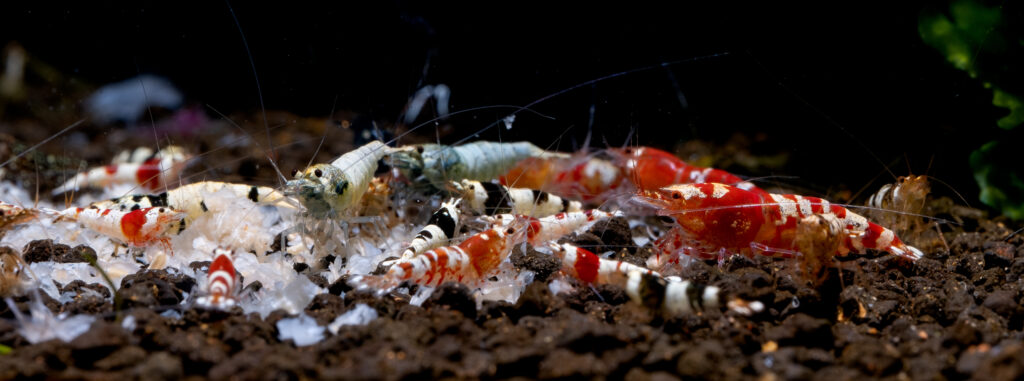
Considerations for shrimp and fish combinations
- Compatibility:
- Choose small, peaceful fish species (e.g., small tetras, rasboras, or dwarf corydoras)
- Avoid known shrimp predators like bettas, cichlids, or larger tetras
- Size matters:
- Ensure fish are small enough that adult shrimp aren’t seen as prey
- Be aware that most fish will prey on shrimplets
- Adjusted stocking rates:
- Reduce shrimp numbers when adding fish
- Example: In a 20-gallon tank, instead of 100 shrimp, stock 50-60 shrimp and a small school of 6-8 nano fish
- Providing safety:
- Increase hiding spots and dense plantings for shrimp
- Create designated “shrimp-only” areas with fine-leaved plants or moss
- Feeding considerations:
- Ensure both fish and shrimp have access to appropriate food
- Be cautious of overfeeding, which can lead to poor water quality
- Species-specific needs:
- Research the specific requirements of both shrimp and fish species
- Ensure water parameters, temperature, and other factors are suitable for all inhabitants
- Quarantine:
- Always quarantine new fish before adding them to a shrimp tank to prevent disease introduction
- Monitoring:
- Observe interactions closely, especially in the first few weeks
- Be prepared to separate species if there are signs of stress or predation
Remember, while mixed species tanks can be visually striking and interesting, they often require more attention and maintenance than single-species setups. Start conservatively and adjust based on the specific dynamics of your tank.
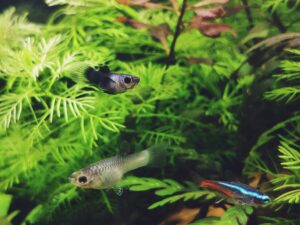
Signs of Overstocking
While shrimp are generally low-bioload creatures, overstocking can lead to various issues that can compromise the health and well-being of your aquatic pets. Recognizing the signs of overstocking early is crucial for maintaining a thriving shrimp colony.
Water quality issues
- Elevated ammonia or nitrite levels:
- These should always be 0 ppm in a healthy tank
- Any detectable levels indicate the bioload may be exceeding the tank’s capacity
- Rising nitrate levels:
- Nitrates climbing faster than usual between water changes
- Levels consistently above 20 ppm despite regular maintenance
- Decreased pH stability:
- More frequent or severe pH swings
- Difficulty maintaining stable pH levels
- Increased algae growth:
- Sudden algae blooms, especially hair algae
- Persistent cloudy water
- Foul odors:
- Any unusual or unpleasant smells from the tank
Increased aggression or stress
- Unusual swimming patterns:
- Shrimp constantly darting around the tank
- Shrimp spending excessive time at the water surface
- Territorial behavior:
- Shrimp fighting over food or hiding spots
- Increased instances of shrimp nipping at each other
- Overcrowding signs:
- Shrimp constantly climbing over one another
- Difficulty finding unoccupied spaces in the tank
- Color changes:
- Shrimp appearing paler or less vibrant than usual
- Increased instances of shrimp turning opaque (a sign of severe stress)
Stunted growth or reduced breeding
- Slower growth rates:
- Juvenile shrimp taking longer to reach adult size
- Adults appearing smaller than typical for the species
- Reduced molting frequency:
- Fewer molts observed in the tank
- Increased occurrences of failed molts
- Breeding issues:
- Fewer berried (egg-carrying) females
- Smaller clutch sizes
- Higher rates of dropped eggs or underdeveloped shrimplets
- Population stagnation:
- Colony size not increasing despite the presence of berried females
- Higher than normal mortality rates, especially among young shrimp
- Weakened immune systems:
- More frequent occurrences of diseases or parasites
- Slower recovery from minor injuries or infections
If you observe any of these signs, it’s important to take action promptly. This may involve reducing the population, increasing maintenance frequency, upgrading filtration, or addressing any other underlying issues contributing to the problem. Remember, a less densely populated tank with healthy, active shrimp is preferable to an overcrowded tank with stressed inhabitants.
Signs of Understocking
While overstocking is a common concern, understocking can also lead to issues in a shrimp tank. Recognizing the signs of understocking is important for maintaining a balanced and thriving ecosystem.
Shy or hiding shrimp
- Excessive timidity:
- Shrimp consistently hiding even during feeding times
- Rarely seeing shrimp in open areas of the tank
- Lack of social behavior:
- Shrimp not forming groups or interacting with each other
- Isolated individuals scattered throughout the tank
- Delayed adaptation:
- New shrimp taking unusually long to acclimate and explore the tank
- Persistent stress behaviors in an otherwise stable environment
Slow colony growth
- Reduced breeding activity:
- Fewer berried females than expected
- Long periods without observing any breeding activity
- Limited genetic diversity:
- Potential inbreeding issues due to a small starting population
- Lack of color or pattern variations in offspring
- Stagnant population:
- Colony size remaining constant over extended periods
- Failure to establish a self-sustaining population
- Slower maturation:
- Juveniles taking longer to reach breeding age
- Delayed development of sexual characteristics
Algae overgrowth
- Excessive algae accumulation:
- Rapid growth of algae on tank surfaces and decorations
- Difficulty controlling algae through normal maintenance
- Imbalanced ecosystem:
- Algae outcompeting plants for nutrients
- Reduced plant health due to algae overgrowth
- Underutilized resources:
- Excess biofilm accumulation on surfaces
- Uneaten food or decaying plant matter
- Water quality implications:
- Potential nutrient imbalances due to insufficient waste processing
- Fluctuations in oxygen levels, especially at night
Additional considerations:
- Predator vulnerability:
- In community tanks, a small shrimp population may be more susceptible to predation
- Difficulty establishing a visible presence in the tank
- Reduced activity levels:
- Less dynamic tank environment
- Fewer interesting behaviors and interactions to observe
- Inefficient biological filtration:
- Understocked tanks may have less robust beneficial bacteria colonies
- Potential for unstable nitrogen cycle when adding new livestock
If you notice these signs of understocking, consider gradually increasing your shrimp population. Start by adding small groups of shrimp and monitor the tank’s response. Remember, the goal is to achieve a balance where the shrimp feel secure, display natural behaviors, and contribute to the overall health of the aquarium ecosystem.
How to Gradually Increase Shrimp Population
Building a thriving shrimp colony requires patience and careful management. A gradual approach to increasing your shrimp population helps ensure a stable, healthy ecosystem.
Starting with a smaller colony
- Begin with a modest number:
- Start with 10-15 shrimp in a 10-gallon tank
- For larger tanks, aim for 1-2 shrimp per gallon initially
- Choose quality stock:
- Select healthy, active shrimp from reputable sources
- Aim for a mix of males and females (if possible to distinguish)
- Allow for acclimation:
- Give the initial colony time to adjust to their new environment
- Monitor closely for the first few weeks
- Establish a stable environment:
- Ensure water parameters are consistent before adding shrimp
- Allow the tank to mature for at least a month before introducing shrimp
Monitoring and adjusting as the population grows
- Regular observation:
- Watch for signs of breeding (berried females)
- Monitor growth rates of juveniles
- Water quality checks:
- Test water parameters weekly
- Look for any changes in ammonia, nitrite, or nitrate levels
- Gradual increases:
- Allow the population to grow naturally through breeding
- If adding new shrimp, introduce small groups (5-10) at a time
- Adjust feeding:
- Increase food quantities gradually as the population grows
- Ensure even distribution to prevent competition
- Enhance habitat:
- Add more plants or hiding spaces as the colony expands
- Consider upgrading filtration if necessary
When to consider culling or rehoming
- Signs it’s time to manage population:
- Difficulty maintaining water quality despite regular maintenance
- Noticeable decrease in shrimp size or vibrancy
- Increased aggression or competition for resources
- Culling options:
- Selectively remove less desirable specimens (e.g., poor coloration)
- Consider using a breeding box to separate and raise high-quality offspring
- Rehoming excess shrimp:
- Offer to local aquarium clubs or stores
- Set up additional tanks for different color morphs or species
- Natural population control:
- Introduce safe predators that may eat some shrimplets (e.g., small fish)
- Reduce feeding slightly to limit population growth
- Establishing a maximum capacity:
- Determine the upper limit for your tank size and filtration capacity
- Aim to maintain the population below this threshold
- Regular assessment:
- Evaluate the population size and tank conditions monthly
- Be proactive in managing growth before issues arise
Remember, a well-managed shrimp colony will often find its own balance over time. Your role is to provide optimal conditions and intervene only when necessary to maintain a healthy, thriving ecosystem.
Advanced Stocking Strategies
For experienced shrimp keepers looking to optimize their setups, advanced stocking strategies can help maximize both breeding success and visual appeal.
Creating breed out tanks vs. display tanks
Breed out tanks:
- Higher stocking densities: Up to 15-20 shrimp per gallon
- Simplified setup: Bare-bottom or light substrate with moss and spawning mops
- Controlled parameters: Precise management of water chemistry
- Selective breeding: Isolation of desired traits
- Frequent water changes: To support higher bioload
Display tanks:
- Lower densities: 5-10 shrimp per gallon for best visual effect
- Aquascaped environment: Focus on aesthetics with plants and hardscape
- Mixed ages: Showcase full life cycle from shrimplets to adults
- Balanced ecosystem: Incorporate complementary species (e.g., snails)
- Less frequent maintenance: Stability prioritized over maximum breeding
Seasonal adjustments to stocking density
- Temperature fluctuations:
- Reduce density in summer when metabolism and oxygen demands increase
- Allow for slightly higher densities in cooler months
- Breeding cycles:
- Increase space during peak breeding seasons (often spring and fall)
- Thin out population before anticipated breeding booms
- Plant growth phases:
- Adjust shrimp numbers based on plant density and health
- Increase stocking as plant mass increases, providing more surface area and filtration
- Seasonal feeding adjustments:
- Modify stocking based on availability of natural foods (e.g., algae growth in summer)
Increasing algae, biofilm, and microorganisms to increase shrimp capacity per tank
- Use of probiotics:
- Introduce beneficial bacteria to boost biofilm production
- Regular dosing can enhance the tank’s carrying capacity
- Lubao soil or other enriched substrates:
- Provides nutrients and surface area for microorganism growth
- Gradually releases minerals beneficial for shrimp and microflora
- Botanicals and leaf litter:
- Add catappa leaves, alder cones, or other botanicals to promote biofilm
- Creates additional grazing surfaces for shrimp
- Controlled lighting:
- Manage photoperiod to encourage balanced algae growth
- Use specific spectrum lights to promote beneficial algae types
- Organic additives:
- Dose with products like Bacter AE to directly feed microorganisms
- Use liquid carbon sources to boost bacterial growth
- Phytoplankton cultivation:
- Introduce and maintain phytoplankton cultures in the tank
- Provides additional food sources and improves water quality
- Rotational fasting:
- Implement periodic fasting days to allow biofilm to replenish
- Encourages shrimp to graze on naturally occurring foods
- Strategic feeding:
- Use feeding dishes to contain excess food
- Offer varied diet to support diverse microorganism population
- Mature filter media:
- Cultivate and transfer mature filter media to seed new tanks quickly
- Maintain a reservoir of beneficial organisms
By implementing these advanced strategies, you can potentially increase the carrying capacity of your shrimp tanks while maintaining a healthy, stable environment. However, always monitor water quality closely and be prepared to adjust your approach based on the specific needs of your shrimp and tank ecosystem.
Determining the optimal number of shrimp per gallon is a nuanced process that requires careful consideration of multiple factors and ongoing observation.
Recap of key factors in determining shrimp per gallon
- Tank size and surface area
- Filtration capacity
- Plant density and availability of hiding spaces
- Shrimp species (Neocaridina vs. Caridina)
- Water parameters and stability
- The presence of other tank inhabitants
- Breeding intentions
- Feeding practices and maintenance routine
Remember that these factors interact with each other, and the ideal stocking density can vary significantly based on your specific setup.
Importance of observation and adjustment
Successful shrimp keeping is an ongoing process that requires:
- Regular monitoring of water parameters
- Observing shrimp behavior and interactions
- Assessing overall tank health and ecosystem balance
- Being willing to make changes based on what you observe
- Understanding that each tank is unique and may require a tailored approach
Don’t hesitate to adjust your stocking levels, maintenance routine, or tank setup if you notice signs of stress or imbalance in your shrimp colony.
Encouragement to start conservatively and increase slowly
For the best chance of success:
- Begin with a lower number of shrimp than you think your tank can handle
- Allow time for the shrimp to acclimate and the tank to stabilize
- Gradually increase the population, either through breeding or careful additions
- Pay close attention to how your tank responds to population increases
- Be patient – a thriving, stable shrimp colony is worth the wait
Remember, in shrimp keeping, quality of life is more important than quantity. A smaller group of healthy, active shrimp is preferable to a larger group under stress.
By starting conservatively, observing closely, and adjusting as needed, you’ll be well on your way to creating a beautiful, thriving shrimp tank that brings joy and fascination for years to come.
FAQs
Can I keep just one or two shrimp in a small tank?
While it’s technically possible to keep a single shrimp or a pair in a small tank, it’s not ideal. Shrimp are social creatures that thrive in groups. A minimum of 5-10 shrimp is recommended, even in small tanks, to:
- Promote natural behaviors
- Reduce stress
- Increase the likelihood of successful breeding
- Create a more stable micro-ecosystem
How quickly will my shrimp population double?
The rate of population growth depends on several factors:
- Species (Neocaridina typically breed faster than Caridina)
- Water conditions
- Availability of food
- Tank size and setup
Under optimal conditions:
- A Neocaridina colony might double every 3-4 months
- Caridina species generally reproduce more slowly
Remember that population growth often slows as the tank reaches its carrying capacity.
Do larger shrimp species require more space per individual?
Yes, larger shrimp species generally require more space per individual. For example:
- Small species (e.g., Cherry Shrimp): 2-5 per gallon
- Medium species (e.g., Amano Shrimp): 1-2 per gallon
- Large species (e.g., Bamboo Shrimp): 1 per 5-10 gallons
Always research the specific needs of the species you’re keeping.
How do I know if my tank is at maximum capacity?
Signs that your tank might be at or near maximum capacity include:
- Difficulty maintaining stable water parameters
- Increased algae growth
- More frequent molting issues
- Reduced breeding rates
- Increased aggression or competition for food
- Slower growth rates in young shrimp
- Shrimp constantly grazing, seeming unable to find enough food
If you notice these signs, consider reducing the population or upgrading your tank.
Should I reduce feeding if I have a high shrimp density?
Not necessarily. With a higher shrimp density, you may need to:
- Feed more frequently, but in smaller amounts
- Ensure food reaches all areas of the tank
- Provide a varied diet to meet all nutritional needs
- Monitor closely for uneaten food and remove it promptly
The key is to find a balance where all shrimp have access to food without overfeeding, which can lead to water quality issues. Consider using feeding dishes to contain food and make it easier to remove excess.
Remember, a significant part of a shrimp’s diet comes from grazing on biofilm and algae in the tank. In a densely populated tank, you may need to take steps to promote the growth of these natural food sources.









